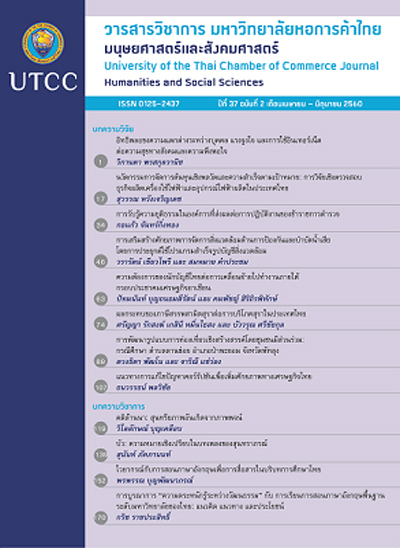Innovations and Their Effects on One Tambon One Product (OTOP) Enterprises’ Performance in Thailand
Main Article Content
Abstract
The objective of this research is to study the four aspects of innovations, including product innovation, process innovation, management innovation and marketing innovation, which affected Thailand OTOP enterprises’ financial and non-financial performance. The population of the research comprised 75,619 Thailand OTOP enterprises in the year 2014. Sample size consisted of 382 enterprises recruited from all parts of Thailand. The data collection tool of this study was questionnaire. Descriptive statistics and multiple regression analysis were executed. Results revealed that (1) the innovations in all aspects of the OTOP enterprises were high and all aspects of their performance were increasing, (2) product and process innovations had positive significant effects on all aspects of financial performance, (3) product innovation, process innovation and management innovation had positive significant effects on all non-financial performances, (4) marketing innovation influenced the performance in these aspects including profit, debt and marketing, and (5) the regression coefficient of determination was not very high. The research suggested that OTOP enterprises should develop all aspects of innovations because innovations were the key factors that affected the performance and the success of OTOP enterprises.
Article Details
ลิขสิทธิ์ของบทความ
ผลงานที่ได้รับการตีพิมพ์ถือเป็นลิขสิทธิ์ของมหาวิทยาลัยหอการค้าไทย ห้ามมิให้นำเนื้อหา ทัศนะ หรือข้อคิดเห็นใด ๆ ของผลงานไปทำซ้ำ ดัดแปลง หรือเผยแพร่ ไม่ว่าทั้งหมดหรือบางส่วนโดยไม่ได้รับอนุญาตเป็นลายลักษณ์อักษรจากมหาวิทยาลัยหอการค้าไทยก่อน
References
Burns, P. (2011). Entrepreneurship and small business (3rd ed.). London, English:Palgrave Macmillan.
Calantone, R.J., Cavusgil, S.T., & Zhao, Y.(2002). Learning orientation, firm innovation capability, and firm performance. Industrial Marketing Management, 31, 515-524.
Cochran, W.G. (1963). Sampling techniques (2nd ed.). New York, NY: John Wiley and Sons.
Community Development Department. (2015). New operations guide for OTOP entrepreneurs of the year 2015. Bangkok, Thailand: Bureau of Local Wisdom Promotion and Community Enterprise. (in Thai).
Dess, G.G., Lumpkin, G.T., Eisner, & Alan, B. (2008). Strategic management (4th ed.). New York, NY: McGraw-Hill.
Ferraresi, A.A., Quandt, C.O., Santos, S.A.dos., & Frega, J.R. (2012). Knowledge management and strategic orientation: leveraging innovativeness and performance. Journal of Knowledge Management, 16, 688-701.
Goyal, P., Rahman, Z., & Kazmi, A.A. (2013). Corporate sustainability performanceand firm performance research. Management Decision, 51(2), 361-379.
Hair, J.F., Black, W.C., Babin, B.J., & Anderson, R.E. (2014). Multivariate data analysis (7th ed.). New York, NY: Pearson Education Limited.
Hamel, G. (2007). The future of management. Boston, MA: Harvard Business School Press.
Hult, G.T.M., Hurley, R.F., & Knight, G.A. (2004). Innovativeness: Its antecedents and impact on business performance. Industrial Marketing Management, 33(5), 429-438.
Kamyabi, Y. (2011). Use of professional accountants’ advisory services and its impact on SME performance in an
emerging economy: A resource-based view. Journal of Management and Sustainability, 1(1), 43-55.
Karabulut, A.T. (2015). Effects of innovation types on performance of manufacturing firms in Turkey. Procedia-Social and Behavioral Sciences, 195, 1355-1364.
Kostopoulos, K.C., Spanos, Y.E., & Prastacos, G.P. (2002). The resource-based view of the firm and innovation: Identification of critical linkages. EURAM Second Annual Conference - Innovation Research in Management. Stockholm, Sweden.
Liao, S., Wu, C., Hu, D., & Tsuei, G.A. (2007). Knowledge acquisition, absorptive capacity, and innovation capability: An empirical study of Taiwan’s knowledgeintensive industries. World Academy of Science, Engineering and Technology, 53, 160-167.
Lin, R.J., Chen, R.H., & Chiu, K.K. (2010). Customer relationship management and innovation capability: An empirical study. Industrial Management & Data Systems,110(1), 111-133.
Lee, J.S., & Hsieh, C.J. (2010). A research in relating entrepreneurship, marketing capability, innovative capability and sustained competitive advantage. Journal of Business & Economics Research, 8(9), 109-119.
Meyer, M.H., & Crane, F.G. (2011). Entrepreneurship: An innovator’s guide to startups and corporate ventures. Thousand, CA: SAGE.
Ndubisi, N.O., & Iftikhar, K. (2012). Relationship between entrepreneurship, innovation and performance comparing small and medium-size enterprises. Marketing and Entrepreneurship, 14(2), 214-236.
Odongo, J. (2014). Lending terms and financial performance of small medium enterprises in Uganda: case of Soroti District. Research Journal of Finance and Accounting, 5(2), 78-91.
Oslo manual: Guidelines for collecting and implementing innovation data. (2005). Retrieved from https://www.oecd-ilibrary. org/docserver/download/9205111e.pdf? expires=1518090164&id=id&accname=guest&checksum=7F2C40CE53E661F09C 9517D8DA29E781
Pelser, T.G. (2014). Sustaining industry leadership through innovation strategy archetypes. International Business & Economics Research Journal, 13(4), 673-714.
Porter, M.E. (1985). Competitive advantage: Creating and sustaining superior performance. New York, NY: The Free Press.
Porter, M.E. (1998). Competitive strategy: Techniques for analyzing industries and competitors. New York, NY: The Free Press.
Ropera, S., Dub, J., & Love, J.H. (2008). Modelling the innovation value chain. Research Policy, 37, 961-977.
Schilling, M.A. (2005). Strategic management of technological innovation. New York, NY: McGraw-Hill.
Sukrungruengsanti, P. (2011). Market innovation on new product development of Thai canned food industry. EAU Heritage Journal: Social Science and Humanities, 5(2), 168-178. (in Thai).
Suwannapusit, U., Pongyeela, A., & Siripanit, P. (2016). The causal relationships between the management activities of the value chain and innovative capability with the performance of One Tambon One Product (OTOP) Group A in Thailand. Journal of Industrial Technology Ubon Ratchathani Rajabhat University, 6(2), 51-62. (in Thai).
Tidd, J., Bessant, J., & Pavitt, K. (2001). Managing innovation: Integrating technological market and organizational change (2nd ed.). Chicester, England:John Wiley & Sons.
Uejirapongpan, S., Wattanasin, P., Chanchai, A., & Kuprat, P. (2010). Innovation: Definition, type, and importance of entrepreneurship. Journal of Business Administration, 33(128), 49-65. (in Thai).


